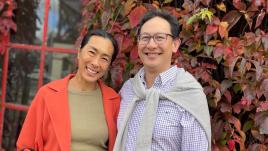Wild wonders: how the UNSW community is rebuilding native ecosystems
Pioneering researchers, backed by community giving, are transforming conservation efforts, ensuring a thriving future for Australia's unique wildlife.
Dr Bec West and Dr Reece Pedler, researchers with the UNSW Wild Deserts project, live more than 1,000 kilometres from Sydney as the on-site custodians of a feral-proof safe haven for native mammals – but they’re not alone.
In 2023, 430 donors from across the UNSW community provided vital funds through the University’s end-of-year appeal to support Bec, Reece and the Wild Deserts team, helping bring wildlife back to fragile desert ecosystems.
Over the past four years, the Wild Deserts team has reintroduced seven locally extinct species into Sturt National Park in the north-western corner of New South Wales. Recent surveys suggest the populations of bilbies, crest-tailed mulgaras, Shark Bay bandicoots and golden bandicoots are now booming.

“These results are so important for the long-term goal of restoring this magnificent desert ecosystem back to something like it once was,” says Professor Richard Kingsford, who leads the Wild Deserts project.
Richard is also a key contributor to the Platypus Conservation Initiative (PCI), led by Dr Gilad Bino. Since launching in 2016, the intrepid PCI team has had a string of achievements – most notably the successful reintroduction of a platypus colony to the Royal National Park in South Sydney in 2023, after more than 50 years of absence.
“The whole project was quite an emotional roller coaster. I have such a strong feeling of responsibility for these platypuses. I wanted to be sure they would be able to establish themselves in their new home,” says Gilad. “We’ve been anxiously tracking the platypuses over the past year, and we’re very glad to see them settling in. In March this year we met a new-emerged juvenile platypus, and it was very uplifting to know that at least one couple has had a puggle.”
Over the past eight years, the PCI team has managed the rescue and short-term relocation of drought-affected platypuses in Tidbinbilla Nature Reserve, collaborated with the Australian Conservation Foundation on the Platy-Project app, developed a Platy-Camp for primary school students in the Illawarra region, and released an animated TED-Ed lesson on ‘one of Earth's weirdest animals’ that has been viewed more than 1.1 million times.
These impactful achievements are the consolidation of years of innovative research, encompassing everything from popular citizen-science data collection projects to the deployment of cutting-edge acoustic and radio-tracking technologies that have changed the way fieldwork is conducted.
The Royal National Park reintroduction, conducted in collaboration with the Taronga Conservation Society, the World Wide Fund for Nature and the NSW National Parks and Wildlife Service, pioneered a holistic approach to species restoration that included an intensive program of baiting for invasive predators.
“This has established conditions that not only benefit the platypus but also enhance the ecological integrity of the entire region,” Gilad explains. “It is providing a resilient habitat for a range of native species and enriching the biodiversity of the Park for future generations.”
Capitalising on the success of the project, Gilad and his team are currently seeking funding to undertake further reintroductions in the Park in 2025.
“I hope the work we are doing fosters a sense of stewardship in people,” says Gilad. “I hope Australians can take pride in the wonderful biodiversity of the land we share.”









